How to read my bill
TEP's rates reflect the cost of providing safe, reliable electric service to our customers. They also reflect the complexity of that task, with fixed charges, usage-based charges and surcharges that can be difficult to understand. The following summary offers explanations for the terms and graphs you'll find on your monthly bill, including links to details posted elsewhere on this website.
Jump to a section: Delivery Services | Power Supply Charges | Surcharges | Taxes and Assessments | Other bill related info
Your TEP Energy Bill

This section provides your account number and an overview of your previous and current charges, including recent payments received and any bill adjustments such as corrections, refunds and fees.
If you participate in our HEERO (Help with Emergency Energy Relief Operation) program to help limited-income customers pay their energy bills, your contribution will display here.
The total amount due is in white against a blue bar so that it stands out prominently.

Service Information
Bill messages will appear in this section in italics. Immediately underneath this message in a light blue box, you will see your service address, the name of your pricing plan, your service number (Service No.), the billing dates and the current charges.
 Billed kWh Usage
Billed kWh Usage
View up to 24 months of history in a graph that compares your most recent 12 months of usage (in dark blue) to the previous 12 months (in light blue). All usage is in kilowatt-hours (kWh). A kilowatt-hour is the use of one kilowatt of electric power for one hour. The dates your meter was read appear beneath the graph, with the date used for your current bill displayed in orange.
 Billing Period Comparison
Billing Period Comparison
This chart compares information from this billing period to the previous billing period as well as to the corresponding billing period from the previous year.
 Average Daily Cost
Average Daily Cost
Your average daily energy cost is highlighted in this orange circle. This figure is based on the current charges divided by the number of days in the billing cycle. Use this feature to compare your energy costs to other daily expenses.
 2 Ways to Save
2 Ways to Save
A colorful graphic provides information about time-of-use and demand-based pricing plans, including the current time-of-use hours, for customers not currently on those plans. Customers on those plans will see a summary of their usage information here.
 Payment Stub
Payment Stub
Your payment stub contains your account number, the payment due date and the total amount due. Space is available to write in your payment amount and an optional contribution for HEERO (Help with Emergency Energy Relief Operation), a program that provides energy bill payment assistance to limited-income customers.
The stub also contains the address where you should send your payment.
Charges
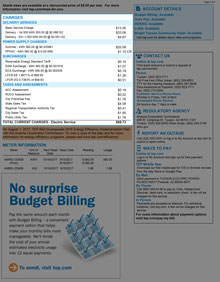
The Arizona Corporation Commission (ACC) sets rates that divide responsibility for these costs among different types of customers — residential, small business, large business and industrial — based on their typical energy usage patterns. TEP's rates are designed to recover the appropriate portion of these costs from each customer group through a combination of fixed fees and usage-based charges.
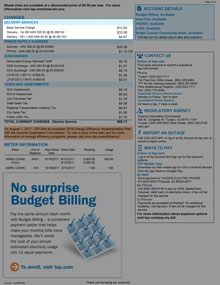
Delivery Services
The charges listed in this section of your bill reflect the cost of delivering power to customers. These charges cover the cost of poles, wires, transformers and other infrastructure; employees and contractors who install, operate and maintain that equipment; and other necessary business expenses.
Power Supply Charges

This section of your bill includes usage-based charges to cover the cost of generating or buying energy for customers.
Surcharges
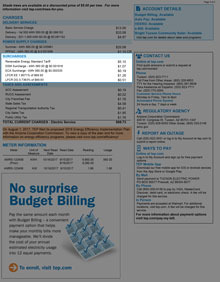
TEP is using more renewable power, helping customers save energy and improving the environmental profile of its generating resources. Some of the costs associated with these efforts are recovered through usage-based surcharges approved by the ACC and listed in this section of your bill.
Taxes and Assessments
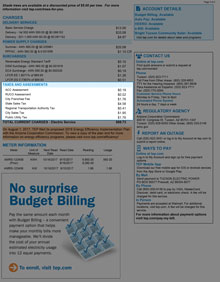 The charges on your bill are subject to government taxes and fees. TEP forwards all of the money collected from these charges to the appropriate authorities.
The charges on your bill are subject to government taxes and fees. TEP forwards all of the money collected from these charges to the appropriate authorities.
Usage Information
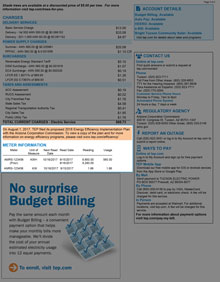
Beginning in summer 2018, all customers will begin seeing their on- and off-peak usage in kilowatt-hours (KWH) and their on- and off-peak demand in kilowatts (KW). For customers who aren’t using a time-of-use or demand-based pricing plan, this data is for informational purposes only.
Time-of-use plans offer lower energy charges during most of the day and higher charges during on-peak hours. Demand plans combine lower usage-based rates with a “demand” charge based on your highest hour of usage during on-peak time periods.
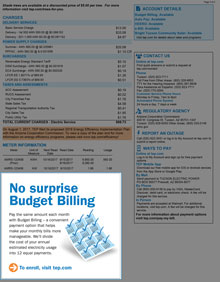
Program Promotions
This section promotes the awareness of programs and services that may interest you.
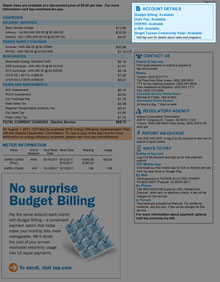
Account Details
In a blue box in the upper right corner, Account Details provides information about program enrollment. The word “Available” will appear if you are not participating in a program but could enroll.
Contact Us and Ways to Pay
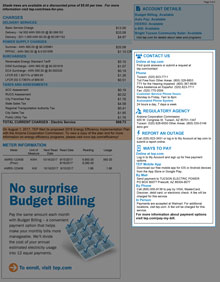 This section of your bill includes contact information for TEP and the ACC, ways you can report a power outage and the multiple ways that you can pay your bill.
This section of your bill includes contact information for TEP and the ACC, ways you can report a power outage and the multiple ways that you can pay your bill.

 Billed kWh Usage
Billed kWh Usage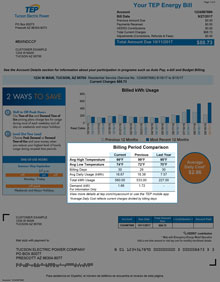 Billing Period Comparison
Billing Period Comparison Average Daily Cost
Average Daily Cost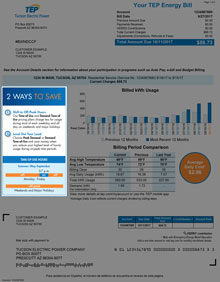 2 Ways to Save
2 Ways to Save Payment Stub
Payment Stub